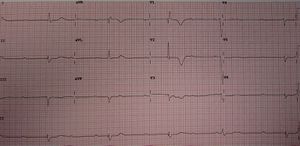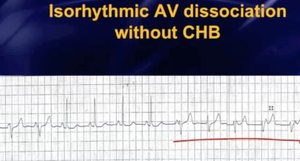We need you! Join our contributor community and become a WikEM editor through our open and transparent promotion process.
Third degree AV block
From WikEM
Contents
Background
- Also known as complete heart block
- No conduction through the AV node, causing the atria and ventricles beat completely independently from each other
- The ventricular beat is an escape rhythm anywhere from the AV node to the bundle-branches (normally slow, varying from 35 to 45 beats per minute)
Causes
- Congenital
- Acquired
- Ischemia
- Drugs
- Structural heart disease
Clinical Features
Differential Diagnosis
AV Blocks
- First degree AV block
- Second degree AV block type I (Wenkebach)
- Second degree AV block type II
- Third degree AV block
- AV dissociation without complete heart block
Evaluation
- No atrial impulses are conducted
- P waves normal and regular P-P intervals unrelated to slower regular R-R intervals
- QRS narrow if block above bundle of His
- QRS wide if block below bundle of His
- PR variable
- Differentiate from AV dissociation without complete heart block
Management
- If symptomatic, standard ACLS guidelines for symptomatic bradycardia to include[1]
- Atropine 0.5mg IV q3-5min prn
- Transcutaneous pacing, followed by transvenous pacing
- Treat underlying etiology
- Avoid AV nodal blocking agents (e.g. beta blockers)
Disposition
- Admission for pacemaker placement
See Also
References
- ↑ Sovari AA et al. Second-Degree Atrioventricular Block Treatment & Management. eMedicine. Apr 28, 2014. http://emedicine.medscape.com/article/161919-treatment#showall.


